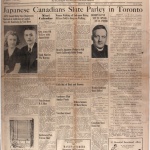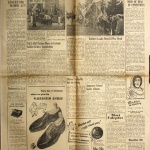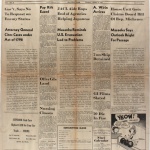Masao Satow
| Name | Masao Satow |
|---|---|
| Born | February 14 1908 |
| Died | March 3 1976 |
| Birth Location | San Mateo, CA |
| Generational Identifier |
Japanese American Citizens League (JACL) leader. An early Nisei leader of the Los Angeles Japanese American community, Masao Satow went on become the national director of the JACL in its postwar heyday, serving in that capacity for twenty-seven years until his 1973 retirement.
Early Life
Masao Satow was born on February 14, 1908, in San Mateo, California, to Shuzo and Kiyose Satow. His family moved to Los Angeles when he was a young child, and he graduated from Polytechnic High School, then from UCLA in 1929. From there, he attended the Princeton Theological Seminary for three years. Returning to Los Angeles in 1932, he became the general secretary of the YMCA's Japanese division and also worked with youth groups at the Japanese Union Church.
Despite his educational attainment, Satow faced the racism that all other Japanese Americans faced in the 1930s. He chose to take a glass half full view, writing hopefully in the Japanese American Courier in 1934, "If each one of us during this coming year were to go out of our way to make one or two meaningful contacts with Americans on the basis of sympathetic understanding and mutual appreciation, we could accomplish much toward hastening the day when we American citizens of Japanese ancestry shall be duly recognized as such." [1] At the same time, in apparent contradiction, his own organization, the YMCA, didn't allow Japanese Americans in its swimming pools, something he pushed to change. [2]
World War II and the JACL
With the attack on Pearl Harbor, Satow was among the Nisei leaders who tried to highlight Japanese American "loyalty" in a futile effort to avoid exclusion. Because he knew Los Angeles County Board of Supervisors chair John Anson Ford through his YMCA work, he led a delegation to visit Ford in an unsuccessful attempt to try to get the board to vouch for the loyalty of the Nisei. Ultimately, Satow and his new bride, Chizuko Uyeda, were sent to the Santa Anita Assembly Center then to the Amache , Colorado War Relocation Authority camp. When allowed to leave the camp, he resettled for a year in Utah, then moved to Milwaukee where he continued his work for the YMCA.
Satow had been involved with the JACL since its second convention in 1932 in Los Angeles. In 1946, he was elected vice president of the organization. But when the organization decided to send national secretary Mike Masaoka to Washington D.C. to become the JACL lobbyist there, Satow was asked to take his place as the national director for a year. Satow agreed. The one year stretched to well over twenty years.
As national director, Satow teamed with Masaoka to preside over the organization during its time of greatest growth and influence. Though Masaoka got most of the headlines, Satow did much of the day-to-day work with the chapters from the national office in San Francisco, with his wife Chizuko as his administrative assistant. "Since they had no children, JACL was their family," wrote JACL in-house historian Bill Hosokawa. "Friendly, outgoing, patient, he had a knack for remembering faces and names, and it is likely that he knew as many Nisei as anyone." [3]
During Satow's tenure the organization led the drive to turn back discriminatory legislation in the decades after the war. Satow was in favor of the organization's contentious support of the Civil Rights Movement in the early 1960s and was part of the Japanese American Research Project committee. He was also part of the fundraising committee that raised half a million dollars for a new headquarters in San Francisco.
He retired on his 65th birthday in 1973 to become a senior adviser to the president of the Sumitomo Bank of California. His succession was contentious, exposing divisions in the organization along generational and regional lines.
Masao Satow died in his sleep at the age of 68 on March 3, 1976. The new headquarters building was rededicated in 1977 as the Masao W. Satow Memorial Building.
For More Information
Hayashi, Brian Masaru. "For the Sake of Our Japanese Brethren": Assimilation, Nationalism, and Protestantism among the Japanese of Los Angeles, 1895-1942 . Stanford: Stanford University Press, 1995.
Hosokawa, Bill. JACL in Quest of Justice: The History of the Japanese American Citizens League . New York: William Morrow, 1982.
Pacific Citizen , March 12, 1976.
"PC Tribute to Mas Satow: Dedication Plus!" Pacific Citizen , Dec. 22–29, 1972, A-1, B-5.
Footnotes
- ↑ Quoted in David Yoo, Growing Up Nisei: Race, Generation, and Culture among Japanese Americans of California, 1924-49 (Urbana: University of Illinois Press, 2000), 74.
- ↑ Brian Masaru Hayashi, "For the Sake of Our Japanese Brethren": Assimilation, Nationalism, and Protestantism among the Japanese of Los Angeles, 1895-1942 (Stanford: Stanford University Press, 1995), 16.
- ↑ Bill Hosokawa, JACL in Quest of Justice: The History of the Japanese American Citizens League (New York: William Morrow, 1982), 320.
Last updated July 7, 2020, 7:48 p.m..








